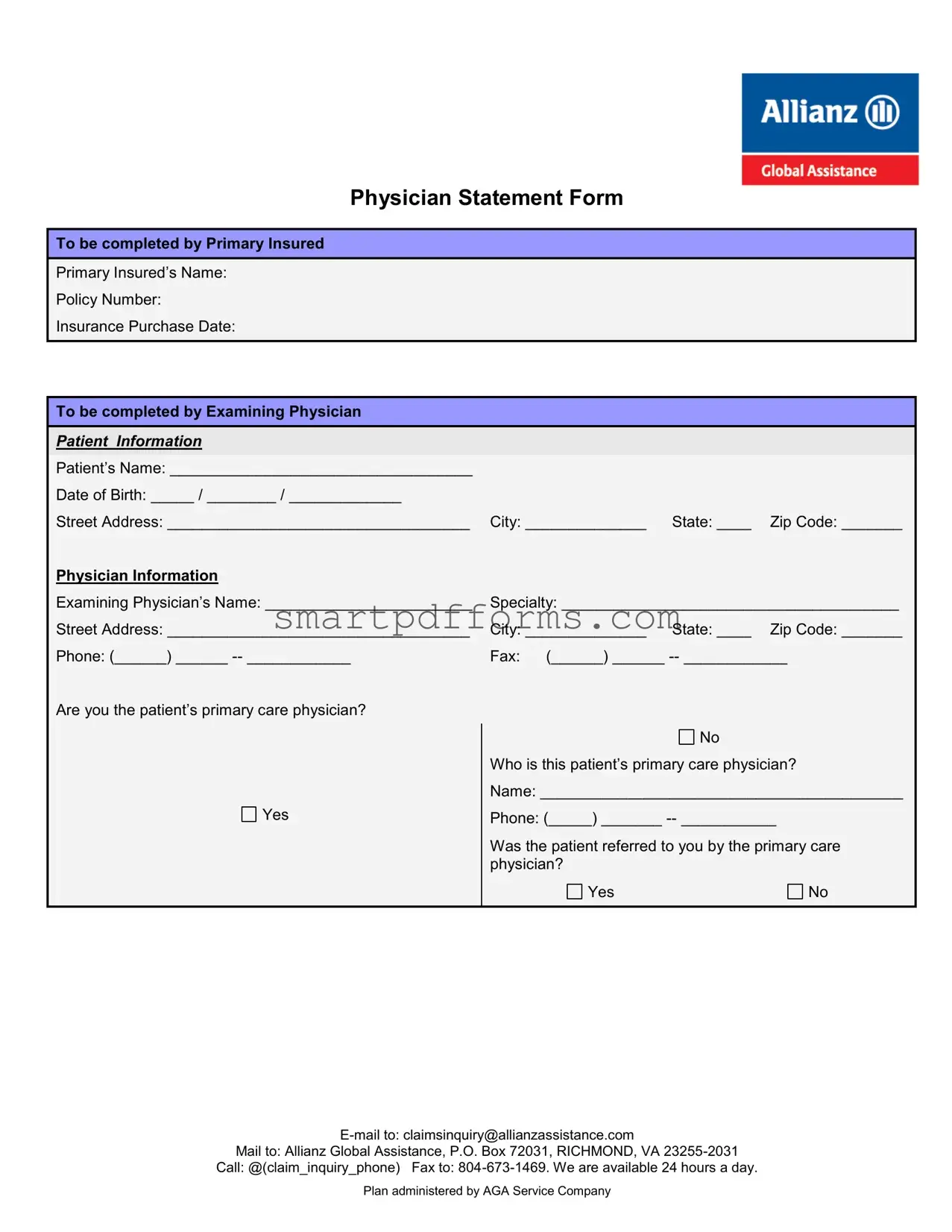Physician Statement Form
To be completed by Primary Insured
Primary Insured’s Name:
Policy Number:
Insurance Purchase Date:
To be completed by Examining Physician
|
|
PATIENT INFORMATION |
|
|
|
|
|
|
|
|
|
|
|
|
|
Patient’s Name: ___________________________________ |
|
|
|
|
|
|
Date of Birth: _____ / ________ / _____________ |
|
|
|
|
|
|
|
|
|
|
|
|
|
Street Address: ___________________________________ |
City: ______________ |
State: ____ |
Zip Code: _______ |
|
|
|
|
|
|
|
|
|
|
|
|
|
|
|
|
Physician Information |
|
|
|
|
|
|
Examining Physician’s Name: ________________________ |
Specialty: _______________________________________ |
|
|
|
|
|
|
|
|
|
|
|
|
|
|
|
|
Street Address: ___________________________________ |
City: ______________ |
State: ____ |
Zip Code: _______ |
|
|
|
|
|
|
|
|
|
|
|
|
|
|
Phone: (______) ______ -- ____________ |
Fax: (______) ______ -- ____________ |
|
|
|
|
|
|
|
|
|
|
|
|
|
|
|
|
|
|
|
|
|
|
|
Are you the patient’s primary care physician? |
|
|
|
|
|
|
|
|
|
No |
|
|
|
|
Who is this patient’s primary care physician? |
|
|
|
Name: __________________________________________ |
|
|
Yes |
Phone: (_____) _______ -- ___________ |
|
|
|
|
|
|
|
|
|
|
Was the patient referred to you by the primary care |
|
|
|
physician? |
|
|
|
|
|
|
Yes |
|
|
No |
|
|
|
|
|
|
|
E-mail to: claimsinquiry@allianzassistance.com
Mail to: Allianz Global Assistance, P.O. Box 72031, RICHMOND, VA 23255-2031
Call: @(claim_inquiry_phone) Fax to: 804-673-1469. We are available 24 hours a day.
Plan administered by AGA Service Company
Patient’s Diagnosis: |
|
|
Did you perform an actual examination? |
Yes |
No |
Date of the exam: ____ / _____ / _________
Please indicate the primary diagnosis for which you examined the patient:
__________________________________________________________________________________________________
__________________________________________________________________________________________________
ICD-9 Code: _______________
Date symptoms first appeared or accident occurred: ____ / _____ / _________ |
|
Is this condition a complication of an underlying condition? |
Yes (specify below) |
No |
__________________________________________________________________________________________________
Please list the dates of the patient’s office visits in the 120 days before the insurance purchase date, noted above. Circle the dates where you treated the patient for the above stated condition.
|
|
____ / _____ / ___________ |
____ / _____ / ___________ |
____ / _____ / ___________ |
____ / _____ / ___________ |
|
|
|
|
____ / _____ / ___________ |
____ / _____ / ___________ |
____ / _____ / ___________ |
____ / _____ / ___________ |
|
|
|
|
|
|
|
|
|
|
|
|
Did you advise the trip be cancelled or interrupted due to the patient’s medical condition? |
|
|
|
|
|
Yes Date: ___ / ___ / _________ |
|
No |
|
|
|
|
Please explain why you made this recommendation. |
Please explain why you did not make this recommendation. |
|
|
|
|
Provide details on the circumstances and medical diagnosis |
Provide details on the circumstances and medical diagnosis |
|
|
|
|
of the patient that you consider relevant to the insured’s |
of the patient that you consider relevant to the insured’s |
|
|
|
|
decision to cancel or interrupt their trip due to injury or |
decision to cancel or interrupt their trip due to injury or |
|
|
|
|
illness. |
|
illness. |
|
|
|
|
|
________________________________________________ |
________________________________________________ |
|
|
|
|
________________________________________________ |
________________________________________________ |
|
|
|
|
________________________________________________ |
________________________________________________ |
|
|
|
|
________________________________________________ |
________________________________________________ |
|
|
|
|
|
|
|
|
|
|
|
|
________________________________________________ |
________________________________________________ |
|
|
|
|
|
|
|
|
|
|
|
|
|
|
|
|
|
|
If the patient is the insured, on what date did he/she become medically unable to travel? |
___ / ___ / ________ |
|
|
|
|
|
|
|
|
|
|
By my signature and stamp below, I hereby certify that the above is true and correct
Physician Signature: _________________________________________________ Date ____/____/______
Physician Stamp:
E-mail to: claimsinquiry@allianzassistance.com
Mail to: Allianz Global Assistance, P.O. Box 72031, RICHMOND, VA 23255-2031
Call: @(claim_inquiry_phone) Fax to: 804-673-1469. We are available 24 hours a day.
Plan administered by AGA Service Company


